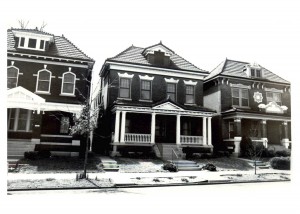When the 1940 census became available, I jumped at the chance to do a little research on my house.
My house was built in 1908. It’s in the city of St. Louis, though the area wasn’t very developed 105 years ago. The house was built as a two-family house and there are four in a row with identical layouts, though with different exterior architectural flourishes. The lore we heard when we bought our house in 1992 was that it was built by a man who lived in the posh neighborhood a block away who had four daughters. He wanted each of them to have a place to live and a source of income. That may explain the beautiful woodwork and stained glass in the houses.
When we first moved in, I went to city hall and found the building permit for the homes, so I verified that they were indeed 1908 houses and that the four houses were built by the same person. I saw the address of that person and committed it to memory– I’ve always felt a kinship with that house, which I pass most days when I walk my dog.
Last year, prompted by the release of the 1940 census, I looked up my house (along with its three sisters) on the 1910, 1920, 1930 and 1940 censuses. To my delight, I was able to verify the story of the houses being occupied by A. H. Witte’s daughters.
I found the address of the man who built my house on the 1900 census and learned that his name was A. H. Witte. I also learned that, just as I’d been told, he had four daughters: Addie (23), Alma (21), Leona (19) and Flora (17), all of whom were living with their parents in 1900.
By 1910, Adelaide was living in my house with her husband of three years and their two children. Alma was living with her husband of nine years and two sons in the house next to ours, to the west. They had a live-in maid. Both couples lived upstairs (the more sunny of the two units in the house) and had tenants downstairs.
Flora, the youngest, was living in 1900 1910 in the house just to the east of ours. She lived with her husband of two years and their baby. Interestingly enough, they chose to live on the first floor and rent out the upstairs unit. In the fourth house, both units were rented and Leona, still single, was living with her parents.
Fast forward 10 years and Addie is still living in my house, but now she has a servant. Alma and Flora are living in their respective houses, on either side of her. All have different tenants. Leona, now 39 years old, is married (to a man seven years her junior) and they have a 10-month-old infant. But they’re living with Leona’s parents, not in the house built for her. I wonder why.
In the 1930 and 1940 censuses, Adelaide had moved out of our two-family house and moved on to a single-family house in the suburbs. I haven’t researched what became of Alma, Leona and Flora after 1920.
What strikes me when I look at my house on the earlier censuses is how many people lived in it. Each unit is about 1600 square feet, with two bedrooms–not tiny, but not huge. In 1920, Addie lived in the upstairs unit with her husband, three children, and a maid. Downstairs, the tenant, Frank Carpenter, lived there with his wife and three teenage kids. That’s a total of 11 people in the house. In 2013, my husband and I live in both units of the house and it’s just the two of us (and always has been).
My understanding is that during World War II, my house was turned into a boarding house, with five units. I believe it, because when we moved in, the house to the west of us had six units. (It was converted more than ten years ago to a luxury single-family.) In nine years, when the 1950 census is released, I’ll be able to verify how many people were living in my house when it was a boarding house. Can’t wait!


A very interesting story and example of how Census data can be used!
P.S. I think you have a typo in the 7th paragraph. Shouldn’t 1900 actually be 1910? Flora was 17 years old in 1900. 🙂
Thank you, John! I appreciate your comment and I appreciate your pointing out the typo. You’re absolutely right, of course. I just fixed it!
It’s so interesting that you’re able to confirm so many details of your house and its inhabitants! In our two-bedroom house, built in California in the 1920’s, there is a tiny room with a window that we use as a walk-in closet. I’ve suspected that it was built as a maid’s room, just big enough for a cot and a chair, when even families in small houses had live-in help. Maybe a census check could say for sure.
There you go, Margaret! If there was a live-in made on enumeration day, she should be on the census.
Fascinating. Thank you for sharing Janine
Thank you, Anthony! Glad you liked it.